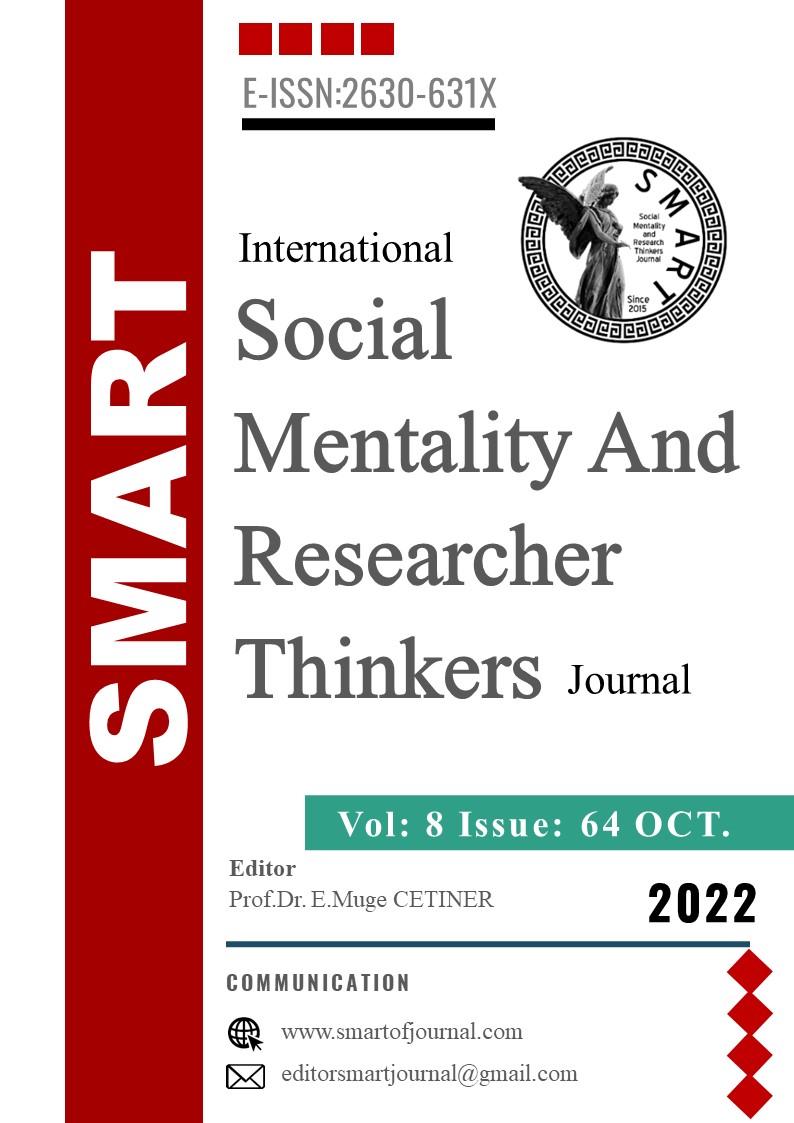Ankara Vakıf Eserleri Müzesinde Bulunan 2007 Ve 2048 Nolu Halılardaki Kompozisyon Ve Motiflerin Değerlendirilmesi
Author :
Abstract
Dünyada var olduğu günden beri insan sosyal ve kültürel bir varlık olarak çevresine ilgi duymuş, bu ilgi neticesinde kültürel birikim sağlamıştır. Kültürel birikimlerimizin içerisinde bir çok değerler bulunmaktadır. Bu değerler içerisinde en önemli unsurların başında geleneksel el sanatlarımız gelmektedir. Geleneksel Türk El Sanatları, Anadolu’nun binlerce yıllık geçmişinde var olan uygarlıkların kültür mirasıyla, içerisinde gelişen öz değerlerin birleştirilmesi sonucu oluşan zengin bir sentezdir. Geleneksel Sanatlarımız içerisinde yer alan halı, bir dokuma türüdür ve dokumalar Türk halkının, doğumundan ölümüne kadar, hayatının bir parçası olmuştur. Halılarımız, geçmişten günümüze Anadolu yaşamını, görsel anlatımındaki zengin ifade gücüyle dile getirme özelliğine sahiptir. Halılardaki görsel anlatımı bu kadar zenginleştiren, içselleştiren ve estetik zarafet katan unsur motiflerdir. Motiflerle duygu, düşünce ve hayata bakış açılarını ince bir estetik anlayış ile görselleştirmişlerdir. İnsanlarımız müthiş bir yaratıcılıkla halıda, kilimde, nakışta işlediği motiflerle; yaşamı, doğumu, ölümsüzlüğü, soyunu, bereketi, bolluğu vb. birçok duyguyu yaşatmıştır. Yaşamsal birçok anlamı içermesinin yanında tarihi bir belge niteliği taşıyan halılarımız günümüzde müzelerde sergilenmekte, kültürel ve sanatsal değerlerinin gün yüzüne çıkarılmasını beklemektedir. Araştırmamızın amacı Ankara Vakıf Eserleri Müzesinde yer alan 2007 ve 2048 nolu halıların kompozisyon ve motif yönünden değerlendirilmesi, kültürel ve sanatsal değerlerinin belirlenmesidir. Bu bağlamda halılarda yer alan motiflerin bulunduğu yörede kullanım sıklığına, ifadesel özelliklerine ve tipolojik unsurlarına değinilmiştir. Kullanılan motifler başka halı örneklerinde yer alan motiflere karşılaştırılarak ortak ve farklı yönleri üzerinde durulmuştur.
Keywords
Abstract
Since the day he existed in the world, man has been interested in his environment as a social and cultural being, and as a result of this interest, he has provided cultural accumulation. There are many values in our cultural accumulations. One of the most important elements among these values is our traditional handicrafts. Traditional Turkish Handicrafts is a rich synthesis formed as a result of combining the cultural heritage of the civilizations that existed in Anatolia's thousands of years of history with the core values that have developed within it. Carpet, which is included in our Traditional Arts, is a type of weaving and weaving has been a part of the life of Turkish people from birth to death. Our carpets have the feature of expressing the Anatolian life from the past to the present with its rich expressive power in its visual expression. The elements that enrich, internalize and add aesthetic elegance to the visual expression on carpets are motifs. With motifs, they visualized their feelings, thoughts and perspectives on life with a fine aesthetic understanding. With the motifs that our people embroider on carpets, rugs and embroidery with great creativity; life, birth, immortality, lineage, fertility, abundance, etc. It evoked many emotions. In addition to containing many vital meanings, our carpets, which are a historical document, are exhibited in museums today, waiting for their cultural and artistic values to be brought to light. The aim of our research is to evaluate the 2007 and 2048 carpets in Ankara Foundation Works Museum in terms of composition and motif, and to determine their cultural and artistic values. In this context, the frequency of use, expressive features and typological elements of the motifs in the carpets are mentioned. The motifs used were compared to the motifs in other carpet samples and their common and different aspects were emphasized.
Keywords
- 1. Aliyeva, M. (2012), Ahıska Türklerinde Halı Kültürü, Arış Halı, Düz Dokuma, Kumaş, Giyim, Kuşam ve İşleme Sanatları Dergisi, Sayı/8.
- 2. Altaş, Naciye. "Vakıflar Genel Müdürlüğü'nün Kaçakçılıkla Mücadele Çalışmaları Yurtdışından Getirilen Vakıf Kültür Varlıkları”, Vakıflar Dergisi, 33 (2010): 145-158.
- 3. Atıcı, Ö. (2022). Osmanlı-Türk Resminde Türk Halıları ve Kilimleri. Güzel Sanatlarda Güncel Araştırmalar, (Edt. Yazıcı, T ve Tankız, K.D.), Gece Kitaplığı, 1. Basım, Ankara.
- 4. Balcı, N. (2012), Türk Halı Sanatında Mitolojik Kaynaklı Bazı Motifler, Arış Halı, Düz Dokuma, Kumaş, Giyim, Kuşam ve İşleme Sanatları Dergisi, Sayı/8.
- 5. Balcı, N. (2021). Türk halı sanatında mitolojik kaynaklı bazı motifler. Arış Dergisi, (8), 38-51.
- 6. Bozkurt, S. (2020). Geleneksel Türk Halı Sanatında Kullanılan Motiflerin Anlamları: Sındırgı-yağcıbedı̇r Halıları Üzerine Göstergebilimsel Bir Analiz. Gümüşhane Üniversitesi İletişim Fakültesi Elektronik Dergisi, 8 (1) , 697-731 . DOI: 10.19145/e-gifder
- 7. Ekici, M. (2016). Türk Kültüründe “Al” Renk. Türk Dünyası İncelemeleri Dergisi, 16(2), 103-107.
- 8. Genç, M. (2012), Günümüz Halı Tasarımlarında Gelenekten Faydalanma Kriterleri. Halıcılık ve Kilimcilik Programının Sorunları ve Çözüm Önerileri Çalıştayı Bildirileri, T.C. Çanakkale On sekiz Mart Üniversitesi, Ayvacık Meslek Yüksekokulu, Nisan.
- 9. Genç, R. (1997). Türk İnanışları ile Milli Geleneklerinde Renkler. Ankara: Atatürk Kültür Merkezi Yayınevi
- 10. Genç, R. (2009). Türk İnanışları ile Milli Geleneklerinde Renkler ve Sarı-Kırmızı-Yeşil. Erdem, 9(27), 1075-1110.
- 11. Gülensoy, T. (1989), Orhun’dan Anadolu’ya Türk Damgaları, TDAV Yay. İstanbul.
- 12. Kaynar, H. (2018). 19. Yüzyıl Sonrası Dokunan Sivas Halısı Desenlerinde Bitkisel Motifler ve Özellikleri. Türk İslâm Medeniyeti Akademik Araştırmalar Dergisi, 13(26), 221-244.
- 13. Koyuncu Okca, A., Genç, M. (2015), Anadolu Halı ve Kilimlerinde Renk. SOBİDER Sosyal Bilimler Dergisi / The Journal of Social Science / Yıl: 2, Sayı: 4, Eylül 2015, s. 235-246.
- 14. MEB. (2012). El Sanatları Teknolojisi- Halı Dokuma, Ankara. http://ismek.ist/files/ismekOrg/file/2013_hbo_program_modulleri/Hal%C4%B1%20Dokuma%20(El%20 Sanatlar%C4%B1).pdf
- 15. Oyman, N. R. (2019). Bazı Anadolu Kilim Motiflerinin Sembolik Çözümlemesi. Arış Dergisi, (14),
- 16. Ögel, B. (1991). Türk kültür tarihine giriş VI. Ankara: Kültür Bakanlığı Yayınları.
- 17. Özkartal, M. (2012). Türk Destanlarında Geçen Halı Anlatımları, Halılardaki Hayvan Motifleri ve Renklerinin Dili. Arış Dergisi, (8), 92-101.
- 18. Öztürk, Ş. (2015). Türk kültüründe renk kavramı ve renklerin maddi kültür unsurlarına yansıması. Yayımlanmamış Doktora Tezi, Kayseri: Erciyes Üniversitesi Sosyal Bilimler Üniversitesi.
- 19. Rayman, H. (2002). Nevruz ve Türk kültüründe renkler. Milli Folklor, 7(53), 10-15.
- 20. Saraç, H. (2022). Türk ve Slav İnanışları ile Geleneklerinde Simgesel Değer Olarak “Kırmızı”. Uluslararası Türkçe Edebiyat Kültür Eğitim (TEKE) Dergisi, 11(2), 657-67
- 21. Zaimoğlu, Ö. (2020), Geçmişten Günümüze Gördes Halıları, (Ömer Zaimoğlu, Edt.), Kardeşler Matbaası- Gazetecilik, Manisa, ss.93-114
- 22. https://www.absurdizi.com/kaplumbaga-terbiye-eden-ressam-osman-hamdi-bey/ (Erişim Tarihi: 3.07.2022)
- 23. https://resimbiterken.wordpress.com/2014/10/23/osman-hamdi-beyin-turbe-ziyaretinde-iki-genc-kiz- eseri/ (Erişim Tarihi: 3.07.2022)





